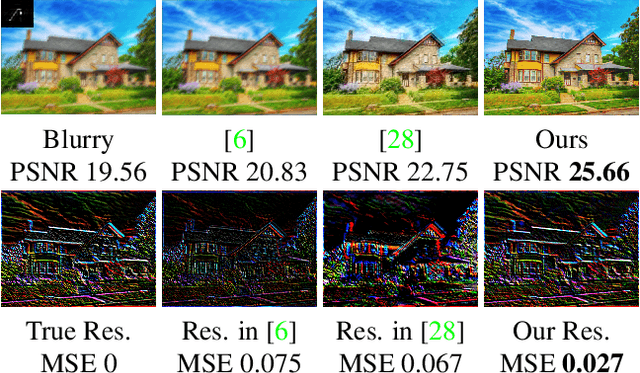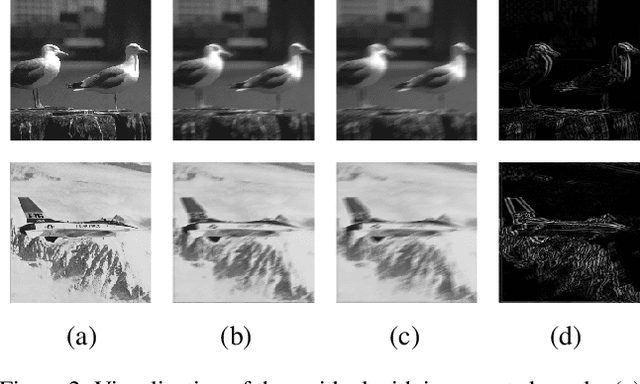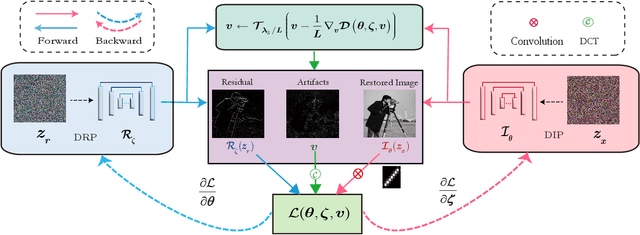Xiaole Tang
BaryIR: Learning Multi-Source Unified Representation in Continuous Barycenter Space for Generalizable All-in-One Image Restoration
May 27, 2025Abstract:Despite remarkable advances made in all-in-one image restoration (AIR) for handling different types of degradations simultaneously, existing methods remain vulnerable to out-of-distribution degradations and images, limiting their real-world applicability. In this paper, we propose a multi-source representation learning framework BaryIR, which decomposes the latent space of multi-source degraded images into a continuous barycenter space for unified feature encoding and source-specific subspaces for specific semantic encoding. Specifically, we seek the multi-source unified representation by introducing a multi-source latent optimal transport barycenter problem, in which a continuous barycenter map is learned to transport the latent representations to the barycenter space. The transport cost is designed such that the representations from source-specific subspaces are contrasted with each other while maintaining orthogonality to those from the barycenter space. This enables BaryIR to learn compact representations with unified degradation-agnostic information from the barycenter space, as well as degradation-specific semantics from source-specific subspaces, capturing the inherent geometry of multi-source data manifold for generalizable AIR. Extensive experiments demonstrate that BaryIR achieves competitive performance compared to state-of-the-art all-in-one methods. Particularly, BaryIR exhibits superior generalization ability to real-world data and unseen degradations. The code will be publicly available at https://github.com/xl-tang3/BaryIR.
Degradation-Aware Residual-Conditioned Optimal Transport for Unified Image Restoration
Nov 03, 2024



Abstract:All-in-one image restoration has emerged as a practical and promising low-level vision task for real-world applications. In this context, the key issue lies in how to deal with different types of degraded images simultaneously. In this work, we present a Degradation-Aware Residual-Conditioned Optimal Transport (DA-RCOT) approach that models (all-in-one) image restoration as an optimal transport (OT) problem for unpaired and paired settings, introducing the transport residual as a degradation-specific cue for both the transport cost and the transport map. Specifically, we formalize image restoration with a residual-guided OT objective by exploiting the degradation-specific patterns of the Fourier residual in the transport cost. More crucially, we design the transport map for restoration as a two-pass DA-RCOT map, in which the transport residual is computed in the first pass and then encoded as multi-scale residual embeddings to condition the second-pass restoration. This conditioning process injects intrinsic degradation knowledge (e.g., degradation type and level) and structural information from the multi-scale residual embeddings into the OT map, which thereby can dynamically adjust its behaviors for all-in-one restoration. Extensive experiments across five degradations demonstrate the favorable performance of DA-RCOT as compared to state-of-the-art methods, in terms of distortion measures, perceptual quality, and image structure preservation. Notably, DA-RCOT delivers superior adaptability to real-world scenarios even with multiple degradations and shows distinctive robustness to both degradation levels and the number of degradations.
Residual-Conditioned Optimal Transport: Towards Structure-preserving Unpaired and Paired Image Restoration
May 05, 2024



Abstract:Deep learning-based image restoration methods have achieved promising performance. However, how to faithfully preserve the structure of the original image remains challenging. To address this challenge, we propose a novel Residual-Conditioned Optimal Transport (RCOT) approach, which models the image restoration as an optimal transport (OT) problem for both unpaired and paired settings, integrating the transport residual as a unique degradation-specific cue for both the transport cost and the transport map. Specifically, we first formalize a Fourier residual-guided OT objective by incorporating the degradation-specific information of the residual into the transport cost. Based on the dual form of the OT formulation, we design the transport map as a two-pass RCOT map that comprises a base model and a refinement process, in which the transport residual is computed by the base model in the first pass and then encoded as a degradation-specific embedding to condition the second-pass restoration. By duality, the RCOT problem is transformed into a minimax optimization problem, which can be solved by adversarially training neural networks. Extensive experiments on multiple restoration tasks show the effectiveness of our approach in terms of both distortion measures and perceptual quality. Particularly, RCOT restores images with more faithful structural details compared to state-of-the-art methods.
Uncertainty-Aware Unsupervised Image Deblurring with Deep Priors Guided by Domain Knowledge
Oct 09, 2022



Abstract:Non-blind deblurring methods achieve decent performance under the accurate blur kernel assumption. Since the kernel error is inevitable in practice, ringing artifacts are often introduced by non-blind deblurring. Recently, semi-blind deblurring methods can handle kernel uncertainty by introducing the prior of the kernel (or induced) error. However, how to design a suitable prior for the kernel (or induced) error remains challenging. Hand-crafted prior, incorporating domain knowledge, generally performs well but may lead to poor performance when kernel (or induced) error is complex. Data-driven prior, which excessively depends on the diversity and abundance of training data, is vulnerable to out-of-distribution blurs and images. To address this challenge, we suggest a data-free deep prior for the kernel induced error (termed as residual) expressed by a customized untrained deep neural network, which allows us to flexibly adapt to different blurs and images in real scenarios. By organically integrating the respective strengths of deep priors and hand-crafted priors, we propose an unsupervised semi-blind deblurring model which recovers the latent image from the blurry image and inaccurate blur kernel. To tackle the formulated model, an efficient alternating minimization algorithm is developed. Extensive experiments demonstrate the superiority of the proposed method to both data-driven prior and hand-crafted prior based methods in terms of the image quality and the robustness to the kernel error.
 Add to Chrome
Add to Chrome Add to Firefox
Add to Firefox Add to Edge
Add to Edge